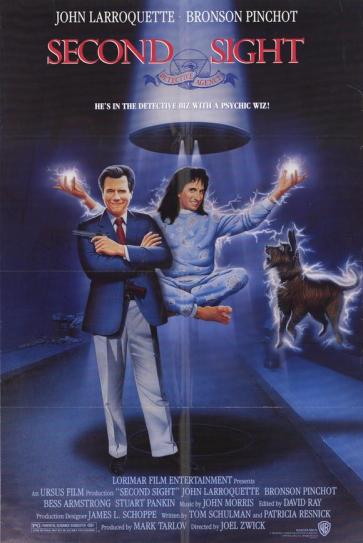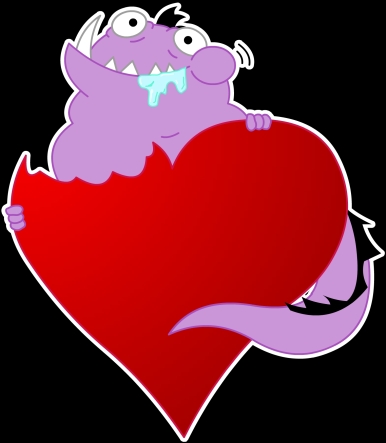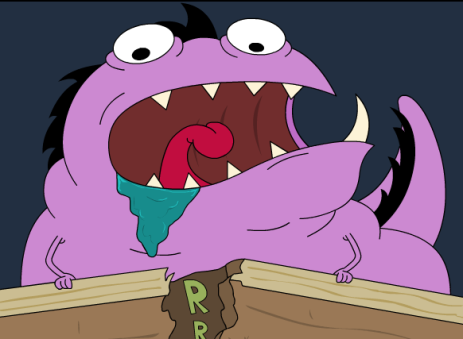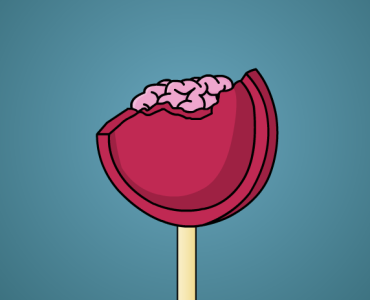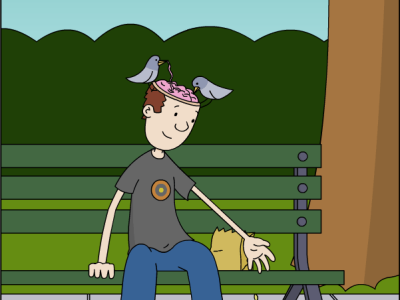
I owe my career as a librarian to the woman who was my boss when I worked in an interlibrary loan department as an undergraduate. For privacy’s sake, let’s call her Beverly.
My first library job was at the same college library, the summer between my freshman and sophomore years, working in the serials & government documents department. I wasn’t working for Beverly yet, I was working under… let’s call her Lois. I was working under Lois for 40 hours per week. My role was to put out the new issues of magazines and academic journals. I would check them in on a computer system, and then I would put Tattle-Tape™ between the pages of the magazines. I was constantly trying to shake the green plastic from the Tattle-Tape™ off my hands. If scientists ever decide they want to switch from nuclear energy to static cling, tell them to look no further than Tattle-Tape™ for boundless stores of it.
When all that was finished, I would take a USPS… what the hell do you even call those things?… a USPS white corrugated plastic mail tote out to the periodicals section on a book cart. Sometimes I would round a corner too fast and the uneven weight of the white corrugated plastic mail tote would cause it to tip over. I would make a small mark along the top of the pages of the previous issues of magazines with a red marker and place them underneath the… what the hell do you even call those things?… under the hinged periodical shelving. If the newest issue was the start of a new volume, or the start of a new year, or if there simply wasn’t room under there, I’d make an additional mark along the top of each issue and bring the whole bunch back to the stacks. For government documents, I’d wrangle with the, uh, regular old library shelves which were choked with hundreds of thin newsprint magazines and pamphlets and fliers, each shelf’s contents permanently slumped to one side, nearly immovable when it came to finding a sliver of space.
Once that summer we sent off rubber-banded stacks of journal issues to a bindery, which would slice off the spines of the magazines and journals and then glue them all together and place a shiny, ugly cover around them, in your choice of colors: caked mustard, abject blue, achromatic purple, or cherry lament. That year, the college had an author-in-residence teaching literature classes, and her husband (of Native American heritage) worked in the same department I did. When the journals came back from the bindery, he and I used… what the hell do you even call those things?… bayonets to insert more Tattle-Tape™ between the spines and the paper blocks. The whole space smelled like glue for a couple of days. They must have set a fan up because I can remember his long hair being blown lazily to one side while we processed the bound journals.
This is infinitely boring to read about, isn’t it? But this was my first job. Those activities are indistinguishable from “that job” in my memory.
I was young and I was Christian and I was the kind of young Christian that actually read the damn book and tried to put stuff into practice. Stuff like Colossians 3:23-24: “And whatsoever ye do, do it heartily, as to the Lord, and not unto men“. I didn’t know enough yet to dislike my serials boss, Lois. I didn’t know how annoying it was that I would show up early. All I knew is that she would lock the door and not let me in until 8. I didn’t know how frustrating it can be to explain to a youngster that we are required by law to give you two fifteen-minute breaks everyday, and you have to take them even if you don’t want them. I was young and I was Christian and I had a Christian girlfriend and we were fucking serious about this stuff.
I could tell you a lot of things to try to prove how utterly Christian I was trying to be. I tithed. (I Was a Teen-Aged Tither!!!) I would get upset if a movie had a swear word in it. I shamed myself for masturbating. I went to a “Weird Al” Yankovic show at the Tabernacle in Atlanta and walked right the fuck out during the opening comedian’s set, which was almost nothing but “jokes” putting down Christian beliefs. I refused to bow my head in common prayer (and refused to let my girlfriend do same) at a campus talk about Mormonism led by Mormons. And believe it or not, me and my Christian girlfriend–for four years–we were chaste.
In retrospect, a lot of my approach to Christianity sprung from a deep-seated need to be more right than others, to be able to point out what they were doing wrong. And as I’m writing this, I’m remembering how restrictive Ephesians 5:4 felt, because I was constantly retconning jokes I made to my girlfriend to not be the dirty joke I originally intended. But also in retrospect, none of the above quite shows how committed I was to trying to be a Christian. I think this does:
While the husband-in-residence and I were sticking strips in books, somehow not getting high off the glue, Beverly came through the room on her way to something else, and I made a joke to her based on a portion of Ecclesiastes 12:12 (“of making many books there is no end”).
Weep for my lost youth, would you?
I was a staunch moralist then, and I think I still am in a lot of ways, at least in terms of having the mindset that there is a right way to do things. When Lois taught me to center the stamp (with the library’s name and address) on each paper side of a bound journal, by God I’d get it centered. She told me to never set books on a cart spine-side up, lest it stress the glue’s bond, and I haven’t done it in the 16 years since. She told me that pictures in magazines were information, and you better damn believe I never put a piece of Tattle-Tape™ over a picture that went all the way to the gutter of the page.
It was my first job, and I gave it my all, and I was working as to the Lord, but somehow by the end of that summer* I somehow had managed to dislike the situation. Whether I was aware then that this stemmed from a dislike of Lois (shared by many in the library, I’d learn over the years), I can’t say now. I didn’t want to work in serials any more. And I certainly didn’t want to work at the circulation desk, as I had the impression that they *shiver* simply sat and read while on the clock. (I know many of you have had the same impression, and the answer is: this both is and is not true.) The idea of collecting a paycheck without working seemed the height of dishonesty. The point is: I didn’t sign up to work in the library the fall of my sophomore year.
But I did continue to use the library. And come the spring semester, Beverly asked me to return. The library had just then lost its interlibrary loan librarian, and Beverly (a reference librarian) was filling in until a new one was hired. She wanted a student to help her with the work and sought me out. Now that I’m writing this, the import of that is finally hitting me. I was one of the “smart” kids in school, and I secretly hated the majority of the other kids in the gifted classes in middle school. I hated that they were more, I don’t know, thoroughly smart kids? That they seemed to be dedicated to it? Let me try to put it a different way: none of them would have laughed at farts or boogers. Definitely our respective parents’ social classes had something to do with it. Anyway, I was a smart kid in school, one of the kind that suddenly finds they aren’t so special once they get into college. Where I had previously gotten perfect grades effortlessly, I suddenly had to write second drafts, I had to study, I had to read books that talked in abstracts and make sense out of them. I was no longer so outstanding. I didn’t appreciate then what it meant that someone like Beverly asked me in particular to come work for her.
Beverly was very different, not only from the other librarians at that college, but from just about everyone I’ve ever met. The campus had houses that faculty and staff could live in (and a waiting list for them a mile long, so I’d heard), and Beverly lived in one. She rode her bike to the library. Beverly worked as the evening reference librarian, and would come in at 11 and leave at 9. She would usually get there, and then immediately leave to head to the dining hall, after which she’d return with a giant salad that would stay on her breath the rest of the day.
Beverly didn’t laugh; Beverly brayed. Beverly was constantly trying to figure out the best filing system for interlibrary loan requests, calling up or visiting various libraries around Atlanta to ask what they did. She wore her eyeglasses on a cord and kept them on top of her head until she need them, at which point she’d get serious and put them on and tilt her head back.
Beverly was an artist. Her office was a mess, filled with stacks of bound (art?) journals which had been removed from the collection, but which she couldn’t let go of. Paintings (some hers) sat propped against the brick walls of her office, which adjoined the interlibrary loan office. There was a second chair in there somewhere. Sometimes Beverly referred to herself as the “intewim intewibwawy woan wibwawian”.
Beverly was a photographer. She went to a UU Church in Marietta and was what I would have described at the time as “new age”. She sometimes wore a t-shirt with a profile of a (college student?) hippo named “Bubbles D. Bimbo”. There was a cartoon of Bubbles on a bicycle and a bunch of text that I never asked Beverly to stand still long enough for me to read. The summers that I worked in interlibrary loan, I would often bring a peanut butter and jelly sandwich for my lunch. Somehow it would inevitably get squished and flattened, and Beverly would poke fun at me for this. Once she even put my sandwich (in its plastic bag) on the scanner and made a picture of it.
Beverly had views far more progressive than I had been exposed to at the time, but Christianity wasn’t unknown to her, so it wasn’t like there was no common ground to discuss things. I remember us both having a discussion with a male Christian student about the rights of a woman to choose to have an abortion (the discussion also revealed that the student’s dad felt he shouldn’t be taxed more because he made a lot of money). Beverly was in her 50s and cut her hair quite short with horse clippers. She showed me a picture of her as a child in Americus, Georgia. She had black hair down to her chin and was wearing a dress and it wasn’t Beverly. It was someone else. It wasn’t Beverly.
I gave Beverly an electronic keyboard that had sat in my room through years of me not admitting to myself I was never going to learn to play it. Beverly would turn on one of the rhythm tracks and improvise. If you told Beverly a corny joke, she would say “Ar ar ar” just like Mork. One Halloween my Christian girlfriend and I went on campus and found Beverly’s house and pretended to trick or treat. From what I could see of Beverly’s house, it was full of books.
Beverly spent lots of money on camera equipment and talked about the store she bought it from, some place I’d never heard of in Atlanta somewhere called “Micro Center”. After I graduated from college, I came back to work at the reference desk in the evenings. Beverly would often bring students into the interlibrary loan office (just off the reference desk) and have them search on one computer while she searched on another). Beverly sometimes felt that the energy coming off the desktop computers was affecting her negatively. Beverly would quote Mr. Bill (“Oh nooo!!”).
Beverly taught me everything I know about answering reference questions, and she taught me far, far more about laughing at work. Beverly made some of the initial strong chinks in the armor of my Christian thinking. Beverly would show me some of the trinkets and art pieces in her office or toys she bought from the Dollar Tree sometimes and it felt like the bit towards the beginning of the 1981 HBO Pee-Wee Herman Show where Pee-Wee’s taking all the toys out of the bag. Beverly often wondered whether she should go back to Americus to take care of her father. Beverly comforted me after my first time dealing with a community patron who talked at me for an hour and a half straight about conspiracy theories. Beverly’s middle name was Earl, just like Jimmy Carter, whose birthplace was 10 miles from her own.
Beverly died of cancer four years ago.
She decided to treat it homeopathically. I was angry for a shorter amount of time than it took you to read this sentence. She wouldn’t have been Beverly if she had done it any other way. I don’t know if the Mr. Bill toy I sent got to her before she died.
The last time I spoke to Beverly, the January before she died, she wasn’t happy with her job at the library anymore.
Beverly alluded vaguely at times to having made decisions based on what her parents wanted. She may not have mentioned it explicitly, but I got the distinct impression that there were things she would have done differently if not for her parents’ views. There was a sense of lost opportunity. I can’t remember if Beverly’s father died while I was working there or not, but it wasn’t terribly long before she herself did.
I suspect that Beverly wanted to be a lesbian. (What are the ethics on theoretically outing a dead person? This is why I changed her name for this story.) The only time I ever saw her come close to the topic of sexuality was when she put one of those… what the hell do you even call those things?… when she put a Pinscreen over her breast for the amusement of the 5-year-old daughter of one of her friends who also worked at the college. I’m going to admit to a pretty stupid mental algorithm of mine: short hair on women=lesbianism/bisexualism. It’s first-order thinking that I’ll never fully shake. Beverly seemed, if anything, to be asexual (retcon that sentence about the Pinscreen to say “over her suggestion of a breast”). She was close to 50 when I first met her, and she was living the life she wanted to, as far as I could tell, so what was there to regret?
I feel that I still have a lot to learn from Beverly. It was at least a few years into my professional career as a librarian before I realized that I had taken her on as a role model. I still want to be more like her (yes, I do sometimes look at horse clippers on Amazon), and I think I could do with contemplating her example more, especially at points in my life like right now**. I wish I had half her compassion and patience and happy spirit and resilience.
I’ll end with my attempt to reconstruct a joke Beverly told me once. I finally found a version of the joke on Reddit, and I’m going to steal heavily from it for this, but I remember Beverly’s wasn’t quite so fully developed, and it certainly didn’t end with the “moral”. I’m going to get parts of it wrong, but at the very least, the girl’s dialogue in the joke is intact.
Charlie Smith was born as a head, nothing else. The doctors said he would never live, but somehow, he did. He had a rough childhood, but he learned to get around, rolling where he needed to, putting up with the teasing and looks. He just tried to fit in as best he could.
By the time he’s in high school, everyone knows him and calls him “Charlie the Head”. He still has a little trouble fitting in, but everyone likes him. He goes to the school Halloween party as a soccer ball, and everyone loves it.
Charlie the Head develops a huge crush on Jessica, one of his classmates. He wants so desperately to be with her and finally gathers up enough courage to ask her on a date. He rolls up to her house and knocks on her door (knock knock knock — imagine the head motions yourself). Jessica opens the door, but looks puzzled until she hears from the ground:
“Hi Jessica, would you like to go on a date?”
“Oh, no, it’s Charlie the Head!”
Jessica, looking disgusted, slams the door. Charlie the Head, dejected, rolls off home. A few days later, Charlie decides to try again. He gets a nice haircut and a bow tie. Charlie the Head rolls up to Jessica’s house, knocks on her door (knock knock knock), and again asks her for a date.
“Oh, no, it’s Charlie the Head!”
Slam.
The third time this happens, before Jessica can close the door on him, Charlie the Head asks her if there’s any possibility she would ever go out with him. Jessica thinks for a moment.
“Okay, Charlie the Head, if you can turn yourself into a grape, I will go on a date with you.”
Charlie the Head rolls back home, feeling utterly hopeless. He prays that night:
“God, please, if you turn me into a grape, I promise to always be a good person.”
The next morning, Charlie the Head wakes up to find that he has indeed turned into a grape! Ebullient, he rolls to Jessica’s house and knocks on her door (squish squish squish). When Jessica comes to the door, Charlie calls up from the ground:
“Jessica, would you like to go on a date?”
Jessica says “Oh no, it’s Charlie the Grape!” and stomps on him. Squish
______________________________________________________________
*which brought with it a $500 bonus for having made it through the whole summer; I believe I spent it on pogs and not my girlfriend. Weep, y’all.
**some of the parts of this story–my boundless enthusiasm for working, having a boss one can relate to and feel a connection with, my sense of ethics when it comes to collecting a paycheck when you sit all day and do nothing–have a far less happy sequel, which I want to tell you about someday, but not for awhile yet. Just remind me.






